
Verona is a city on the Adige River in Veneto, Italy, with 258,031 inhabitants. It is one of the seven provincial capitals of the region, and is the largest city municipality in the region and in northeastern Italy. The metropolitan area of Verona covers an area of 1,426 km2 (550.58 sq mi) and has a population of 714,310 inhabitants. It is one of the main tourist destinations in Northern Italy because of its artistic heritage and several annual fairs and shows as well as the opera season in the Arena, an ancient Roman amphitheater.

A city gate is a gate which is, or was, set within a city wall. It is a type of fortified gateway.

City Gate is a gate located at the entrance of Valletta, Malta. The present gate, which is the fifth one to have stood on the site, was built between 2011 and 2014 to designs of the Italian architect Renzo Piano.

The Castello Sforzesco is a medieval fortification located in Milan, Northern Italy. It was built in the 15th century by Francesco Sforza, Duke of Milan, on the remnants of a 14th-century fortification. Later renovated and enlarged, in the 16th and 17th centuries it was one of the largest citadels in Europe. Extensively rebuilt by Luca Beltrami in 1891–1905, it now houses several of the city's museums and art collections.

Michele Sanmicheli (1484–1559), was a Venetian architect and urban planner of Mannerist-style, among the greatest of his era. A tireless worker, he was in charge of designing buildings and religious buildings of great value.

The Porta San Paolo is one of the southern gates in the 3rd-century Aurelian Walls of Rome, Italy. The Via Ostiense Museum is housed within the gatehouse. It is in the Ostiense quarter; just to the west is the Roman Pyramid of Cestius, an Egyptian-style pyramid, and beyond that is the Protestant Cemetery.

The Porta del Popolo, or Porta Flaminia, is a city gate of the Aurelian Walls of Rome that marks the border between Piazza del Popolo and Piazzale Flaminio.
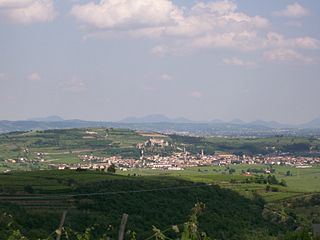
Soave is a small comune of the Veneto region in the Province of Verona, northern Italy, with a population of roughly 6,800 people.

Lazise is a comune (municipality) and town in the Province of Verona in the Italian region Veneto, located about 120 kilometres west of Venice and about 20 kilometres northwest of Verona. It is situated on the eastern shore of Lake Garda. As of 31 December 2004, it had a population of 6,213 and an area of 65.0 square kilometres (25.1 sq mi). This geographical location empowers a position of great landscape value, but it also features elements of great architectural value and of great historical importance.

The Veronese Easter was a rebellion during the Italian campaign of 1797, in which inhabitants of Verona and the surrounding areas revolted against the French occupying forces under Antoine Balland, while Napoleon Bonaparte was fighting in Austria. The uprising received its name through association with the anti-French uprising of the Sicilian Vespers of the 13th century. Incited by oppressive behaviour by the French, it began on the morning of 17 April 1797, the second day of Easter: the enraged population succeeded in defeating more than a thousand French soldiers in the first hour of fighting, forcing them to take refuge in the town's fortifications, which the mob then captured by force. The revolt ended on 25 April 1797 with the encirclement and capture of the town by 15,000 soldiers, who then forced it to pay a huge fine and hand over various assets, including artwork.

Batignano is a small town in southern Tuscany, a frazione of the comune of Grosseto, positioned at about 10 km north-east of the capital on one of the last foot-hills of the valley of Ombrone which dominated the ancient city of Roselle.

Porta Sempione is a city gate of Milan, Italy. The name is used both to refer to the gate proper and to the surrounding district (quartiere), a part of the Zone 1 division, including the major avenue of Corso Sempione. The gate is marked by a landmark triumphal arch called Arco della Pace, dating back to the 19th century, although its origins can be traced back to a gate of the Roman walls of Milan.
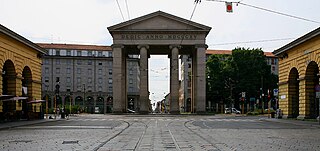
Porta Ticinese is a former city gate of Milan, Italy. The gate, facing south-west, was first created with the Spanish walls of the city, in the 16th century, but the original structure was later demolished and replaced in the early 19th century. The name "Porta Ticinese" is used both to refer to the gate proper and to the surrounding district, part of the Zone 6 administrative division. In the same district there is also a medieval gate with the same name, although in common speech the name "Porta Ticinese" is usually assumed to refer to the 19th century gate.
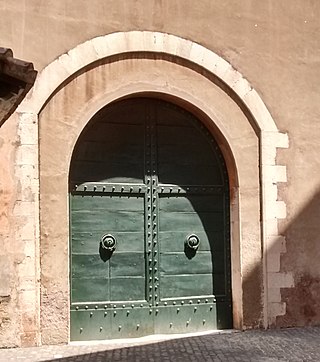
Porta San Pellegrino is a gate in the outer wall of Vatican City. It is located beside Bernini's Colonnade and the small Vatican post; it is also known as Porta Viridaria. The gate was rebuilt by Pope Alexander VI in 1492 and his arms are at the top of the gate. The gate is little used.
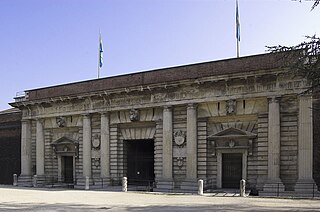
Porta Palio is a gate or portal of the former outer medieval walls of the city of Verona, Italy. It was designed and built during 1550–1561 by the architect Michele Sanmicheli.
Porta San Zeno was a gate or portal of the former outer medieval walls of the city of Verona, Italy. It was designed and built during 1542 by the architect Michele Sanmicheli.

Porta Vescovo was a gate or portal of the former outer medieval walls of the city of Verona, Italy. It was designed and built during 1520 by the architect Teodoro Trivulzio. It is named Vescovo, because the gate once collected a toll benefitting the bishop.
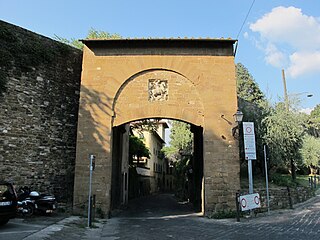
The Porta San Giorgio is a medieval gateway located on the south-east end of the Oltrarno walls of Florence, Italy. Ramparts of the Belvedere fortress, begun in 1590, stand adjacent to the gate. The road away from Florence soon passes the church of San Leonardo in Arcetri.

Porta Nuova is a gateway to the historic center of Verona, built between 1532 and 1540. It was designed by architect Michele Sanmicheli. Giorgio Vasari said of the gateway in Le vite de' più eccellenti pittori, scultori e architettori "never before any other work of more grandeur or better design."


















